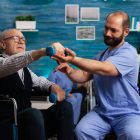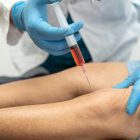Synopsis
The elbow joint is notoriously prone to stiffness following trauma, making specialized post-fracture care mandatory for a full return to function. Dedicated physio for elbow fracture protocols are essential for safely restoring range of motion lost during immobilization. This guide details the systematic approach of elbow fracture physical therapy, which minimizes the formation of restrictive scar tissue. Finding an expert physio for fractured elbow specialist is crucial for safe, progressive mobilization. We explore the critical role of broken elbow physio in rebuilding strength and preventing chronic stiffness. Utilizing comprehensive physio for elbow care ensures all surrounding structures are addressed. The ultimate goal is functional restoration through meticulous physical therapy for broken elbow intervention. Consistent physio for elbow fracture minimizes long-term functional loss. Expert elbow fracture physical therapy ensures mobility is regained without compromising bone healing. A skilled physio for fractured elbow meticulously guides the patient through strengthening exercises. Dedicated broken elbow physio ensures power and endurance are restored. Comprehensive physio for elbow rehabilitation is key for durability. Meticulous physical therapy for broken elbow is crucial post-trauma. Advanced physio for elbow fracture and systematic elbow fracture physical therapy are the cornerstones of post-trauma care. Overcoming stiffness requires an expert physio for fractured elbow. Dedicated broken elbow physio and focused physio for elbow care ensure complete restoration, proving the value of professional physical therapy for broken elbow programs.
Table of Contents
- The Elbow Stiffness Challenge Post-Trauma
- Essential Protocols for Physio For Elbow Fracture
- Systematic Elbow Fracture Physical Therapy for Mobility
- The Role of the Expert Physio for Fractured Elbow Specialist
- Rebuilding Function- The Critical Phase of Broken Elbow Physio
- Comprehensive Physio for Elbow Care- Addressing the Kinetic Chain
- Functional Restoration through Physical Therapy for Broken Elbow
- The Orthocure Advantage- Integrated Post-Trauma Solutions
- Partnering with Orthocure for Durable Elbow Function
The Elbow Stiffness Challenge Post-Trauma
The elbow is unique among major joints for its extreme susceptibility to stiffness following trauma or prolonged immobilization. Even a seemingly minor fracture can lead to a severe, persistent loss of flexion and extension, critically compromising the ability to perform basic tasks like reaching the mouth or dressing. This debilitating consequence, known as post-traumatic stiffness, is caused by scar tissue formation and capsular tightening. Overcoming this requires an immediate, cautious, and highly specialized therapeutic approach. Without expert intervention, the functional loss from a fracture can be permanent, making specialized post-trauma rehabilitation non-negotiable for regaining a full, active range of motion.
Essential Protocols for Physio For Elbow Fracture
Effective physio for elbow fracture protocols are meticulously designed to restore joint mobility safely without stressing the healing bone or fixation hardware. The process begins with passive and gentle active range-of-motion exercises, often performed within a pain-free range, to maintain fluid dynamics and prevent adhesion formation. This initial phase of physio for elbow fracture must be guided by a specialist who understands the mechanical tolerance of the healing joint. The pace of mobilization is critical: too slow, and stiffness sets in; too fast, and the healing tissue can be damaged. This delicate balance is the hallmark of successful post-fracture care.
Systematic Elbow Fracture Physical Therapy for Mobility
Systematic elbow fracture physical therapy is the blueprint for reversing the effects of immobilization. The therapist employs techniques such as sustained joint mobilizations, dynamic splinting (if necessary), and specialized stretching to gently push the limits of the stiff joint capsule. The main goal of elbow fracture physical therapy is to regain the full arc of movement necessary for functional tasks. As mobility is restored, strengthening exercises are integrated, always ensuring that the muscle activation reinforces the corrected movement patterns. This disciplined progression is essential for overcoming the joint’s stubborn tendency toward stiffness.
What are the risks of aggressive mobilization after an elbow fracture?
The Role of the Expert Physio for Fractured Elbow Specialist
The expertise of a dedicated physio for fractured elbow specialist is crucial for navigating the complex post-trauma landscape. This clinician possesses the critical knowledge to interpret the orthopaedic reports, understand the specific type of fracture (e.g., radial head or olecranon), and tailor the rehabilitation based on the bone’s healing status. A skilled physio for fractured elbow can precisely gauge when to transition from protective mobilization to aggressive strengthening, ensuring that the patient’s recovery is maximized without complications. Their continuous assessment prevents common pitfalls like pain-induced muscle guarding and ensures the therapeutic window for mobility restoration is fully utilized.
Rebuilding Function- The Critical Phase of Broken Elbow Physio
Once initial mobility is secured, the program transitions into the critical functional phase of broken elbow physio . The goal of broken elbow physio is to rebuild the significant muscle mass and endurance lost during immobilization. This involves targeted strengthening of the biceps, triceps, and forearm muscles using resistance training, starting with low load and high repetition. The exercises are progressed to incorporate functional movements that mimic daily tasks, ensuring the patient regains the power and stability needed for lifting, carrying, and pushing. Restoring this functional capacity is what ultimately determines the patient’s long-term independence.
How is muscle strength measured and progressed after a fracture?
Comprehensive Physio for Elbow Care- Addressing the Kinetic Chain
Comprehensive physio for elbow care extends beyond the joint itself to address the entire kinetic chain—the shoulder and wrist. Stiffness in the elbow often leads to compensatory movements in the shoulder, causing secondary pain and impingement. Therefore, effective physio for elbow rehabilitation includes mobilization of the shoulder and wrist joints and strengthening of the scapular stabilizers. This holistic approach ensures that the entire upper limb functions harmoniously, preventing strain from being transferred to other areas and accelerating the patient’s return to a balanced, pain-free movement pattern.
Functional Restoration through Physical Therapy for Broken Elbow
Functional restoration is the ultimate objective of physical therapy for broken elbow protocols. This involves integrating the newly restored mobility and strength into real-world movements. The therapist employs specialized drills that simulate occupational tasks or athletic movements to ensure the joint can withstand dynamic stress. Meticulous physical therapy for broken elbow ensures that the patient’s grip, carrying capacity, and reaching power are fully recovered. This attention to detail is vital for complex injuries and proves that a full, pain-free return to all pre-injury activities is achievable with structured, expert guidance.
What specific exercises restore triceps function post-fracture?
The Orthocure Advantage- Integrated Post-Trauma Solutions
ORTHOCURE CLINICS AND GYMS distinguishes itself by offering integrated, specialized solutions for complex post-trauma cases, ensuring every patient receives the highest standard of physio for elbow fracture . Our unique 4 Point Protocol guarantees that the elbow fracture physical therapy is standardized, precise, and focused on Structural Correction over temporary relief. We integrate Orthopaedic Doctors, dedicated Physiotherapists, and Chiropractors to manage the complexity of recovery collaboratively. Furthermore, we utilize advanced strengthening equipment, such as the MedX, USA machines , to safely and precisely rebuild the muscle power lost during immobilization, guaranteeing the most durable long-term outcome.
How does Orthocure’s protocol ensure structural correction for the elbow?
Partnering with Orthocure for Durable Elbow Function
The services offered by ORTHOCURE CLINICS AND GYMS provide a complete pathway to long-term functional recovery. We offer expert physio for fractured elbow and advanced physical therapy for broken elbow protocols, prioritizing non-surgical, evidence-based solutions. The ultimate USP of ORTHOCURE CLINICS AND GYMS is its dedication to Structural Correction through integrated physio for elbow care, ensuring the root cause of stiffness and weakness is permanently addressed. By partnering with Orthocure, you gain access to a protocol-driven pathway that guarantees the highest standard of care and a confident return to an active, pain-free life.
What preventative care is offered after the elbow is fully healed?
FAQs
Why is the elbow joint so prone to stiffness after a fracture?
The elbow joint is notoriously prone to stiffness after a fracture because of its complex bony structure and tendency to form scar tissue quickly in response to trauma and immobilization. The joint capsule tightens rapidly, and the muscles around the joint can shorten, leading to a permanent loss of motion if not treated promptly. This quick onset of stiffness means that specialized physio for elbow fracture must begin early and be meticulously managed to break down the restrictive tissue and maintain fluid joint movement, preventing the loss of essential functional range.
What techniques are used in elbow fracture physical therapy to combat scar tissue formation?
In elbow fracture physical therapy , techniques to combat scar tissue formation include specialized manual therapy, such as deep soft tissue mobilization, and controlled, repetitive range-of-motion exercises. The therapist also uses gentle sustained stretching and, in some cases, modalities like therapeutic ultrasound to enhance tissue healing and promote the realignment of collagen fibers. This consistent and controlled mechanical stress is essential for preventing the scar tissue from becoming restrictive and for maintaining the mobility gained during the broken elbow physio sessions.
How does a physio for fractured elbow specialist ensure safe mobilization?
A physio for fractured elbow specialist ensures safe mobilization by meticulously following the surgeon’s protocol and gauging the patient’s pain response. They begin with passive and active range-of-motion exercises within a strict, non-painful arc, preventing excessive force that could disrupt the healing bone. They prioritize low-load movements and utilize visual feedback to ensure the patient avoids compensatory motions. This expert oversight is critical because aggressive mobilization can cause re-injury, while insufficient mobilization leads to chronic stiffness, proving the value of professional care.
What is the difference between physio for elbow care and general arm exercises?
Specialized physio for elbow care differs from general arm exercises by focusing on a specific, therapeutic goal based on a precise diagnosis. It involves high-precision manual mobilization and targeted eccentric strengthening to correct structural faults, like joint stiffness or tendon pathology. General arm exercises aim for overall conditioning but lack the necessary biomechanical specificity and oversight, which can aggravate a condition like a fracture. A dedicated physio for elbow fracture program ensures that every movement is restorative and safe for the compromised joint.
How important is the strengthening phase of broken elbow physio for long-term function?
The strengthening phase of broken elbow physio is paramount for long-term function, as it provides the dynamic stability necessary for functional tasks. While early mobilization restores range, building muscle strength in the biceps, triceps, and forearm is what allows the patient to lift, push, and pull without pain. The strengthening protocols, which are a core part of physical therapy for broken elbow , are often progressed to functional, sport-specific movements, ensuring the patient’s limb is not only mobile but resilient enough to withstand the stresses of daily life, preventing a relapse of weakness and stiffness.
When can a patient typically expect to regain full elbow extension and flexion?
The timeline for regaining full elbow extension and flexion can vary greatly depending on the fracture type and severity, but patients undergoing dedicated physical therapy for broken elbow can often expect significant improvement within 3 to 6 months. For highly complex injuries, regaining the last few degrees of motion can take up to a year. Consistent, daily adherence to the home exercises prescribed by the physio for fractured elbow specialist is the most critical factor influencing the speed and extent of motion regained.
Why is comprehensive physical therapy for broken elbow necessary to address the shoulder and wrist?
Comprehensive physical therapy for broken elbow is necessary to address the shoulder and wrist because the elbow is part of the upper extremity kinetic chain. Immobilization of the elbow can cause stiffness in the wrist and lead to compensatory movement in the shoulder, potentially causing secondary pain or impingement. Therefore, effective elbow fracture physical therapy includes mobilization of adjacent joints and strengthening of the shoulder’s stabilizing muscles, ensuring the entire limb functions harmoniously and reducing the overall risk of future injury.





